THE EMPIRE OF BABYLON UNDER KING NEBUCHADNEZZAR II (605 BC – 562 BC ) WAS ALSO KNOWN AS CHALDEAN EMPIRE.THE ISHTAR GATE AS PART OF NEBUCHADNEZZAR'S PLAN TO BEAUTIFY HIS EMPIRE'S CAPITAL DURING THE FIRST HALF OF 6TH CENTURY BC. (BEFORE CHRIST ERA)
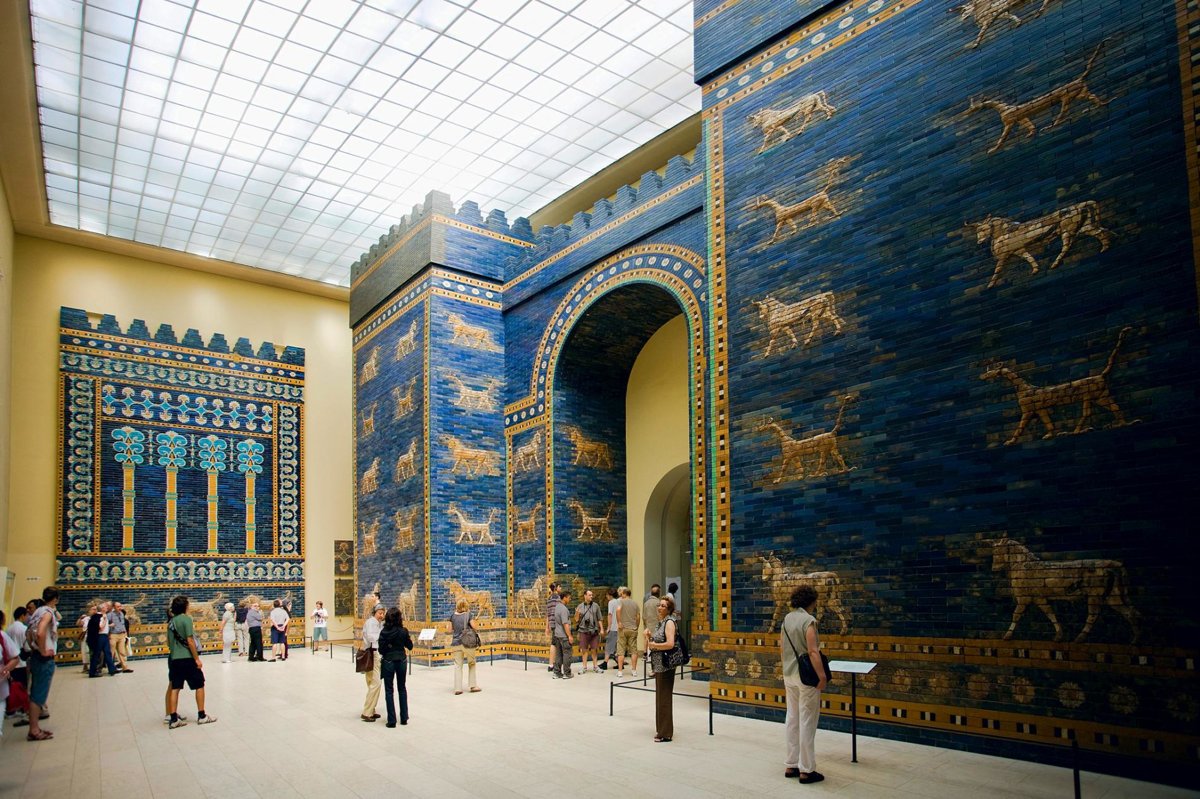 The Ishtar Gate was the most elaborate of the inner city gates constructed in Babylon in antiquity. The whole gate was covered in lapis lazuli glazed bricks which would have rendered the façade with a jewel-like shine. Alternating rows of lion and cattle march in a relief procession across the gleaming blue surface of the gate.
The Ishtar Gate was the most elaborate of the inner city gates constructed in Babylon in antiquity. The whole gate was covered in lapis lazuli glazed bricks which would have rendered the façade with a jewel-like shine. Alternating rows of lion and cattle march in a relief procession across the gleaming blue surface of the gate.The Babylonian Empire was the most powerful state in the ancient world after the fall of the Assyrian empire (612 BCE). Its capital Babylon was beautifully adorned by king Nebuchadnezzar, who erected several famous buildings. Even after the Babylonian Empire had been overthrown by the Persian king Cyrus the Great (539), the city itself remained an important cultural center.After the fall of the Akkadian Empire, two new empires rose to power. They were the Babylonians in the south and the Assyrians to the north. The Babylonians were the first to form an empire that would encompass all of Mesopotamia.The Akkadian Empire usually refers to the Semitic speaking state that grew up around the city of Akkad north of Sumer, and reached its greatest extent under Sargon of Akkad (2296-2240 B.C.E.). It has been described as the first true empire in world history. It was a flourishing civilization in one of the most fertile areas of the globe, the alluvian plain of Southern Mesopotamia that fed into the later Babylonian Civilization. Women appear to have been respected and to have played a significant role in the religious cultus. King Sargon was the first ruler to unite the peoples of Southern Mesopotamia into a single political unit. He established a strong, centralized state. Cities, though, used to independence competed for preeminence, which appears to have eventually brought about the Empire's decline. It was followed by the Babylonian Civilization.The Chaldeans, who inhabited the coastal area near the Persian Gulf, had never been entirely pacified by the Assyrians. About 630 Nabopolassar became king of the Chaldeans. In 626 he forced the Assyrians out of Uruk and crowned himself king of Babylonia. He took part in the wars aimed at the destruction of Assyria. At the same time, he began to restore the dilapidated network of canals in the cities of Babylonia, particularly those in Babylon itself. He fought against the Assyrian Ashur-uballit II and then against Egypt, his successes alternating with misfortunes. In 605 Nabopolassar died in Babylon.The Ishtar Gate, named after a Mesopotamian goddess of love and war, was one of eight gateways that provided entry to the inner city of Babylon during the reign of Nebuchadnezzar II (reign 605-562 B.C.). It was decorated with glazed blue bricks that depicted alternating rows of bulls and dragons.The Hanging Gardens of Babylon evoke a romantic picture of lush greenery and colorful flowers cascading from the sky. The grandeur of their sight must have been awe-inspiring, which is why Herodotus would have considered them one of his Seven Wonders of the Ancient World. However, not only are the Hanging Gardens of Babylon not standing today, but their entire existence is debated. Because of the lack of documentation of them in the chronicles of Babylonian history, many doubt they were ever there. They were built in the year 600 p.n.e. At the request of King Nebuchadnezzar II, who gave it to his wife, Amytis, who, upon his arrival in Babylon, lacked the lush vegetation of his native country, Medii. It is unclear why they were called Semiramida, an Assyrian queen who lived two centuries earlier.The Tower of Babel,origin myth meant to explain why the world's peoples speak different languages.Some modern scholars have associated the Tower of Babel with known structures, notably the Etemenanki, a ziggurat dedicated to the Mesopotamian god Marduk by Nabopolassar, the king of Babylonia circa 610 BCE.The Great Ziggurat of Babylon was 91 metres (300 ft) in height. Alexander the Great ordered it to be demolished circa 331 BCE in preparation for a reconstruction that his death forestalled.The Chaldeans, who inhabited the coastal area near the Persian Gulf, had never been entirely pacified by the Assyrians. About 630 Nabopolassar became king of the Chaldeans. In 626 he forced the Assyrians out of Uruk and crowned himself king of Babylonia. He took part in the wars aimed at the destruction of Assyria. At the same time, he began to restore the dilapidated network of canals in the cities of Babylonia, particularly those in Babylon itself. He fought against the Assyrian Ashur-uballit II and then against Egypt, his successes alternating with misfortunes. In 605 Nabopolassar died in Babylon.Nebuchadrezzar II had named his oldest son, Nabu-kudurri-usur, after the famous king of the second dynasty of Isin, trained him carefully for his prospective kingship, and shared responsibility with him. When the father died in 605, Nebuchadrezzar was with his army in Syria; he had just crushed the Egyptians near Carchemish in a cruel, bloody battle and pursued them into the south. On receiving the news of his father's death, Nebuchadrezzar returned immediately to Babylon. In his numerous building inscriptions he tells but rarely of his many wars; most of them end with prayers. The Babylonian chronicle is extant only for the years 605-594, and not much is known from other sources about the later years of this famous king. He went very often to Syria and Palestine, at first to drive out the Egyptians. In 604 he took the Philistine city of Ashkelon. In 601 he tried to push forward into Egypt but was forced to pull back after a bloody, undecided battle and to regroup his army in Babylonia. After smaller incursions against the Arabs of Syria, he attacked Palestine at the end of 598. King Jehoiakim of Judah had rebelled, counting on help from Egypt. According to the chronicle, Jerusalem was taken on March 16, 597. Jehoiakim had died during the siege, and his son, King Johoiachin, together with at least 3,000 Jews, was led into exile in Babylonia. They were treated well there, according to the documents. Zedekiah was appointed the new king. In 596, when danger threatened from the east, Nebuchadrezzar marched to the Tigris River and induced the enemy to withdraw. After a revolt in Babylonia had been crushed with much bloodshed, there were other campaigns in the west.
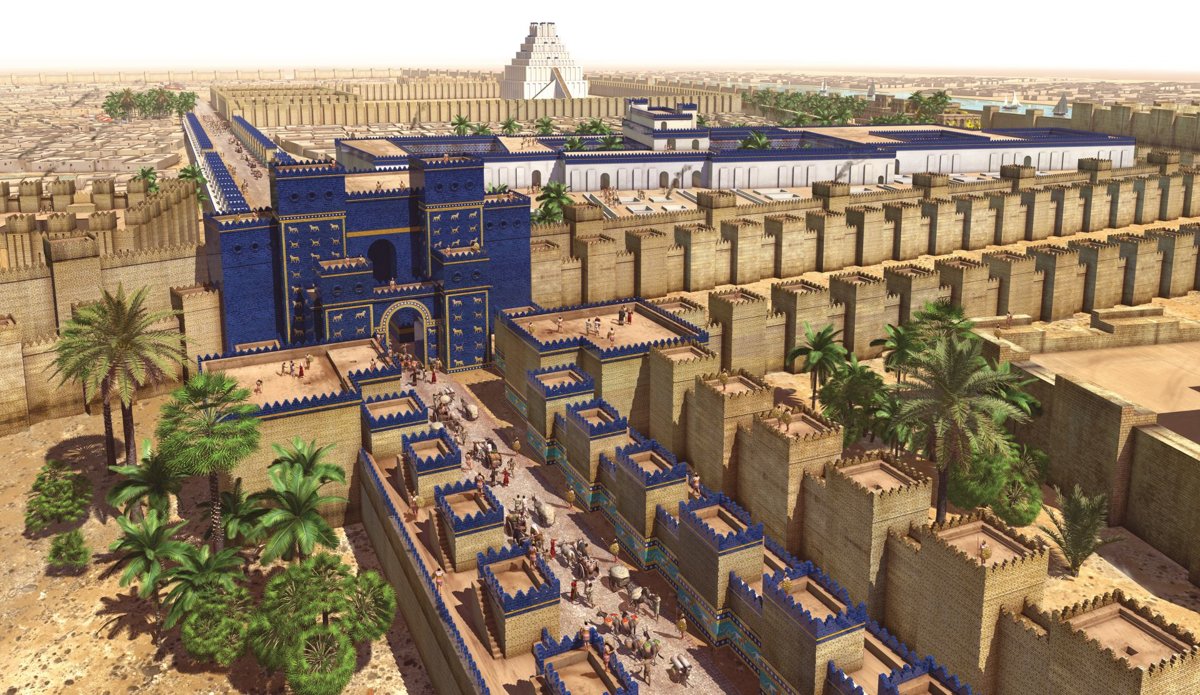
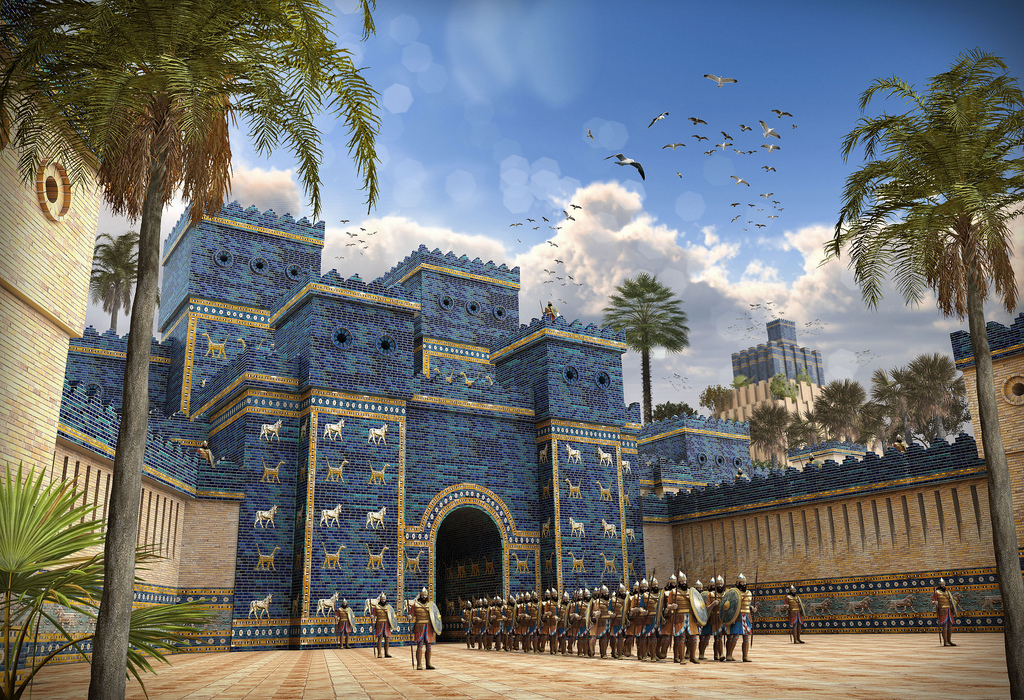 The Ishtar Gate was constructed by the Babylonian King Nebuchadnezzar II circa 575 BC.This enormous burnt-brick entryway was located over the main thoroughfare in the ancient city of Babylon (now in Iraq). Built about 575 BC, it became the eighth fortified gate in the city.The Ishtar Gate was more than 38 feet (12 meters) high and was decorated with glazed brick reliefs, in tiers, of dragons and young bulls.
The Ishtar Gate was constructed by the Babylonian King Nebuchadnezzar II circa 575 BC.This enormous burnt-brick entryway was located over the main thoroughfare in the ancient city of Babylon (now in Iraq). Built about 575 BC, it became the eighth fortified gate in the city.The Ishtar Gate was more than 38 feet (12 meters) high and was decorated with glazed brick reliefs, in tiers, of dragons and young bulls.
The Assyrian Empire expanded, conquered and ruled the Middle East, including Mesopotamia, Egypt, the eastern coast of the Mediterranean, and parts of today’s Turkey, Iran and Iraq. Since around 1250 B.C., the Assyrians had started using war chariots and iron weapons, which were far superior to bronze weapons. Much of Assyria's history is closely tied to its southern neighbor, Babylonia. The two Mesopotamian empires spoke similar languages and worshipped most of the same gods. They were often rivals on the battlefield for influence in the ancient Middle East.These tools and tactics made the Assyrian army the most powerful military force of its time, both doctrinally and technologically advanced.A series of kings from Adad-Nirari II (c. 912-891 B.C.) to Adad-Nirari III (811 to 806 B.C.) fought to expand the empire. The powerful Assyrian army conquered its enemies city by city, as it excelled in siege warfare as well as battlefield tactics. The Assyrians were the first army to contain a separate engineer corps. Assyrians moved mobile ladders and ramps right up against heavily fortified city walls. Sappers and miners dug underneath the walls. Massive siege engines became prized Assyrian armaments. Successfully taking city after city, the Assyrians extended their empire throughout the Middle East and down the Levant coast. After Adad-Nirari III’s reign, however, the empire again stagnated.The final stage of the Assyrian empire began in 745 B.C. when Tiglath Pileser III took the throne. Tiglath Pileser III received the empire in a slump with a demoralized army and disorganized bureaucracy. He took control and began reorganizing all aspects of the empire from the army to the bureaucracy to re-conquering rebellious provinces. Tiglath Pileser ended military conscription, replacing it with levy requirements from the provinces and vassals. His reorganized army became the model for efficiency, training and tactics for any military coming later.The Assyrian empire was renowned not only for its powerful military machine, but also for its progress in the arts, culture, medicine and education. While deportations of segments of conquered populations continued, all subjugated regions were accepted and treated as Assyrians.Following Tiglath Pileser III, the Assyrian empire was ruled by Shalmaneser V, Sargon II and Sennacherib. Sennacherib’s reign (705 to 681 B.C.) welded the empire into an even greater force; he conquered provinces in Anatolia, Judah and Israel, even sacking Jerusalem. Sennacherib moved the capital of Assyria to Nineveh, where he built a splendid palace and exquisite gardens, which might have been the famous Hanging Gardens.Sennacherib’s son, Esarhaddon and grandson Ashurbanipal both ruled well, if ruthlessly. They expanded the empire, consolidated its power and stabilized all the regions under their control. This security and stability allowed the arts to flourish. With the wealth that poured into Nineveh, artisans created many beautiful objects from jewelry to wrought iron temple gates. Ashurbanipal (668 to 627 B.C.) became the most literate of the Assyrian kings, collecting a vast library of cuneiform tablets from all over the known world.Ashurbanipal was the last great Assyrian king. After his reign of 42 years, the huge empire began to fall apart. It had become too large, taxes were too high and entire regions rebelled. In 612 B.C., Nineveh itself was razed by a host of Persians, Babylonians and Medes. The great Assyrian empire was over.
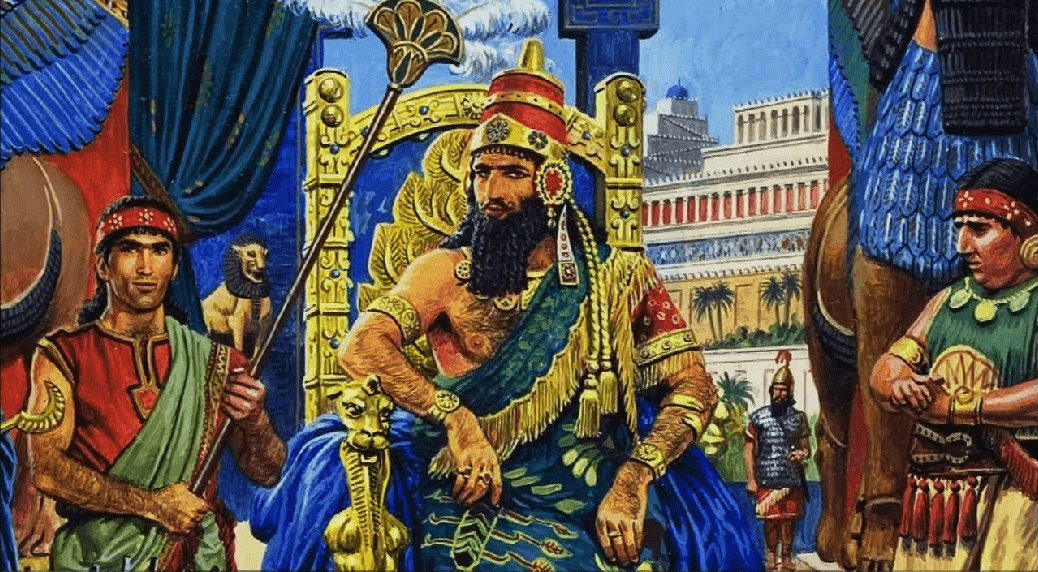
 King Nebuchadnezzar II was ruler of Babylonia c. 605–561 BC. He expanded his empire while building the city of Babylon into a wonder of the ancient world.Nebuchadnezzar II was the most powerful of the Babylonian kings. His name is explained to mean "Nebo is the protector against misfortune." He led his army against Pharaoh-necho, king of Egypt, defeated him at Carchemish, B.C. 605, recovered Coele-Syria, Phoenicia and Palestine, took Jerusalem, pressed forward to Egypt, and was engaged in that country or upon its borders when intelligence arrived which recalled him hastily to Babylon.
King Nebuchadnezzar II was ruler of Babylonia c. 605–561 BC. He expanded his empire while building the city of Babylon into a wonder of the ancient world.Nebuchadnezzar II was the most powerful of the Babylonian kings. His name is explained to mean "Nebo is the protector against misfortune." He led his army against Pharaoh-necho, king of Egypt, defeated him at Carchemish, B.C. 605, recovered Coele-Syria, Phoenicia and Palestine, took Jerusalem, pressed forward to Egypt, and was engaged in that country or upon its borders when intelligence arrived which recalled him hastily to Babylon.
King Nebuchadrezzar II (605 BC – c. 562 BC) was the oldest son and successor of Nabopolassar, founder of the Chaldean empire. He is known from cuneiform inscriptions, the Bible and later Jewish sources, and classical authors. His name, from the Akkadian Nabu-kudurri-usur, means "O Nabu, watch over my heir. While his father disclaimed royal descent, Nebuchadrezzar claimed the third-millennium Akkadian ruler Naram-Sin as ancestor. The year of his birth is uncertain, but it is not likely to have been before 630 BC, for according to tradition Nebuchadrezzar began his military career as a young man, appearing as a military administrator by 610. He is first mentioned by his father as working as a labourer in the restoration of the temple of Marduk, the chief god of the city of Babylon and the national god of Babylonia.In 607/606, as crown prince,Nebuchadrezzar commanded an army with his father in the mountains north of Assyria, subsequently leading independent operations after Nabopolassar's return to Babylon. After a Babylonian reverse at the hands of Egypt in 606/605, he served as commander in chief in his father's place and by brilliant generalship shattered the Egyptian army at Carchemish and Hamath, thereby securing control of all Syria. After his father's death on Aug. 16, 605, Nebuchadrezzar returned to Babylon and ascended the throne within three weeks. This rapid consolidation of his accession and the fact that he could return to Syria shortly afterward reflected his strong grip on the empire.On expeditions in Syria and Palestine from June to December of 604, Nebuchadrezzar received the submission of local states, including Judah, and captured the city of Ashkelon. With Greek mercenaries in his armies, further campaigns to extend Babylonian control in Palestine followed in the three succeeding years. On the last occasion (601/600), Nebuchadrezzar clashed with an Egyptian army, with heavy losses; this reverse was followed by the defection of certain vassal states, Judah among them. This brought an intermission in the series of annual campaigns in 600/599, while Nebuchadrezzar remained in Babylonia repairing his losses of chariots. Measures to regain control were resumed at the end of 599/598 (December to March). Nebuchadrezzar's strategic planning appeared in his attack on the Arab tribes of northwestern Arabia, in preparation for the occupation of Judah. He attacked Judah a year later and captured Jerusalem on March 16, 597, deporting King Jehoiachin to Babylon. After a further brief Syrian campaign in 596/595, Nebuchadrezzar had to act in eastern Babylonia to repel a threatened invasion, probably from Elam (modern southwestern Iran). Tensions in Babylonia were revealed by a rebellion late in 595/594 involving elements of the army, but he was able to put this down decisively enough to undertake two further campaigns in Syria during 594.Nebuchadrezzar's further military activities are known not from extant chronicles but from other sources, particularly the Bible, which records another attack on Jerusalem and a siege of Tyre (lasting 13 years, according to the Jewish historian Flavius Josephus) and hints at an invasion of Egypt. The siege of Jerusalem ended in its capture in 587/586 and in the deportation of prominent citizens, with a further deportation in 582. In this respect he followed the methods of his Assyrian predecessors.Much influenced by the Assyrian imperial tradition, Nebuchadrezzar consciously pursued a policy of expansion, claiming the grant of universal kingship by Marduk and praying to have "no opponent from horizon to sky." From cuneiform fragments he is known to have attempted the invasion of Egypt, the culmination of his expansionist policy, in 568/567.In addition to being a brilliant tactician and strategist, Nebuchadrezzar was also prominent in international diplomacy, as shown in his sending an ambassador (probably Nabonidus, a successor) to mediate between the Medes and Lydians in Asia Minor. He died about 561 and was succeeded by his son Awil-Marduk .Nebuchadrezzar's main activity, other than as military commander, was the rebuilding of Babylon. He completed and extended fortifications begun by his father, built a great moat and a new outer defense wall, paved the ceremonial Processional Way with limestone, rebuilt and embellished the principal temples, and cut canals. This he did not only for his own glorification but also in honor of the gods. He claimed to be "the one who set in the mouth of the people reverence for the great gods" and disparaged predecessors who had built palaces elsewhere than at Babylon and had only journeyed there for the New Year Feast.Little is known of his family life beyond the tradition that he married a Median princess, whose yearning for her native terrain he sought to ease by creating gardens simulating hills. A structure representing these hanging gardens cannot be positively identified in either the cuneiform texts or the archaeological remains.Despite the fateful part he played in Judah's history, Nebuchadrezzar is seen in Jewish tradition in a predominantly favorable light. It was claimed that he gave orders for the protection of Jeremiah, who regarded him as God's appointed instrument whom it was impiety to disobey, and the prophet Ezekiel expressed a similar view at the attack on Tyre.Nebuchadrezzar appears as a man, initially deceived by bad advisers, who welcomes the situation in which truth is triumphant and God is vindicated.There is no independent support for the tradition of Nebuchadrezzar's seven years' madness, and the story probably arose from a fanciful later interpretation of texts concerned with events under Nabonidus, who showed apparent eccentricity in deserting Babylon for a decade to live in Arabia.The Babylonian empire under Nebuchadrezzar extended to the Egyptian border. It had a well-functioning administrative system. Though he had to collect extremely high taxes and tributes in order to maintain his armies and carry out his building projects, Nebuchadrezzar made Babylonia one of the richest lands in western Asia the more astonishing because it had been rather poor when it was ruled by the Assyrians. Babylon was the largest city of the "civilized world." Nebuchadrezzar maintained the existing canal systems and built many supplementary canals, making the land even more fertile. Trade and commerce flourished during his reign.Nebuchadrezzar's building activities surpassed those of most of the Assyrian kings. He fortified the old double walls of Babylon, adding another triple wall outside the old wall. In addition, he erected another wall, the Median Wall, north of the city between the Euphrates and the Tigris rivers. According to Greek estimates, the Median Wall may have been about 100 feet high. He enlarged the old palace and added many wings, so that hundreds of rooms with large inner courts were now at the disposal of the central offices of the empire. Colourful glazed-tile bas-reliefs decorated the walls. Terrace gardens, called the Hanging Gardens in later accounts, were added. Hundreds of thousands of workers must have been required for these projects. The temples were objects of special concern. He devoted himself first and foremost to the completion of Etemenanki, the "Tower of Babel." Construction of this building began in the time of Nebuchadrezzar I, about 1110. It stood as a "building ruin" until the reign of Esarhaddon of Assyria, who resumed building about 680 but did not finish. Nebuchadrezzar II was able to complete the whole building. The mean dimensions of Etemenanki are to be found in the Esagila Tablet, which has been known since the late 19th century. Its base measured about 300 feet on each side, and it was 300 feet in height. There were five terracelike gradations surmounted by a temple, the whole tower being about twice the height of those of other temples. The wide street used for processions led along the eastern side by the inner city walls and crossed at the enormous Ishtar Gate with its world-renowned bas-relief tiles. Nebuchadrezzar also built many smaller temples throughout the country. The Ishtar Gate was constructed by the Babylonian King Nebuchadnezzar II circa 575 BCE. It was the eighth gate of the city of Babylon and was the main entrance into the city. The Ishtar Gate was part of Nebuchadnezzar's plan to beautify his empire's capital and during the first half of the 6th century BCE, he also restored the temple of Marduk and built the renowned wonder: the Hanging Gardens as part of this plan. The magnificence of the Ishtar Gate was so well known that it made the initial list of the Seven Wonders of the Ancient World. In 539 BC, Cyrus invaded Babylonia. Nabonidus sent his son Belshazzar to head off the huge Persian army; however, already massively outnumbered, Belshazzar was betrayed by Gobryas, Governor of Assyria, who switched his forces over to the Persian side. The Babylonian forces were overwhelmed at the battle of Opis. Nabonidus fled to Borsippa, and on 12 October, after Cyrus' engineers had diverted the waters of the Euphrates, "the soldiers of Cyrus entered Babylon without fighting." Belshazzar in Xenophon is reported to have been killed, but his account is not held to be reliable here. Nabonidus surrendered and was deported. Gutian guards were placed at the gates of the great temple of Bel, where the services continued without interruption. Cyrus arrived in Babylon on 3 October, Gobryas having acted for him in his absence. Gobryas was then made governor of the province of Babylon.The city of Babylon makes its first appearance in our sources after the fall of the Empire of the Third Dynasty of Ur, which had ruled the city states of the alluvial plain between the rivers Euphrates and Tigris for more than a century . An agricultural crisis meant the end of this centralized state, and several more or less nomadic tribes settled in southern Mesopotamia. One of these was the nation of the Amorites , which took over Isin, Larsa, and Babylon. Their kings are known as the First Dynasty of Babylon.The area was reunited by Hammurabi, a king of Babylon of Amorite descent . From his reign on, the alluvial plain of southern Iraq was called, with a deliberate archaism, Mât Akkadî, "the country of Akkad", after the city that had united the region centuries before. We call it Babylonia. It is one of the most fertile and rich parts of the ancient world.First, Babylon and its ally Larsa fought a defensive war against Elam, the archenemy of Akkad. After this war had been brought to a successful end, Hammurabi turned against Larsa, and defeated its king Rim-Sin. This scenario was repeated. Together with king Zimrilim of Mari, Hammurabi waged war against Aššur, and after success had been achieved, the Babylonians attacked their ally. Mari was sacked. Other wars were fought against Jamšad (Aleppo), Elam, Ešnunna, and the mountain tribes in the Zagros. Babylon now was the capital of the entire region between Harran in the northwest and the Persian Gulf in the southeast.Hammurabi's successes became the problems of his successors. After the annexation of Mari in the northwest and Ešnunna in the east, there was no buffer against the increasing power of the Hittite Empire (in Anatolia) and the Kassite tribes in the Zagros. It was impossible for the successors of Hammurabi to fight against all these enemies at the same time, and they started to loose grip. In the deep south, we find independent rulers (the Sea Land Dynasty). The enemies sometimes invaded Babylonia, and in 1595 , the Hittite king Mursilis I advanced along the Euphrates, sacked Babylon, and even took away the statue of the supreme god of Babylonia, Marduk, from its temple, the Esagila.Babylon was not Cyrus’s first victory, but it was the most earth-shattering. October, 539 BC. Cyrus rode into Babylon as its new king, adding the greatest empire in the world, the Babylonian empire, to his increasing holdings. That moment has been remembered as one of liberation.The end of Babylon,in 539 B.C. under their king Cyrus II. He also devoted himself to the renovation of many temples, taking an especially keen interest in old inscriptions. He gave preference to his god Sin and had powerful enemies in the priesthood of the Marduk temple. Modern excavators have found fragments of propaganda poems written against Nabonidus and also in support of him.Internal difficulties and the recognition that the narrow strip of land from the Persian Gulf to Syria could not be defended against a major attack from the east induced Nabonidus to leave Babylonia around 552 and to reside in Taima in northern Arabia. There he organized an Arabian province with the assistance of Jewish mercenaries. His viceroy in Babylonia was his son Bel-shar-usur, the Belshazzar of the Book of Daniel in the Bible. Cyrus turned this to his own advantage by annexing Media in 550. Nabonidus, in turn, allied himself with Croesus of Lydia in order to fight Cyrus. Yet, when Cyrus attacked Lydia and annexed it in 546, Nabonidus was not able to help Croesus. Cyrus bode his time. In 542 Nabonidus returned to Babylonia, where his son had been able to maintain good order in external matters but had not overcome a growing internal opposition to his father. Consequently, Nabonidus' career after his return was short-lived, though he tried hard to regain the support of the Babylonians. He appointed his daughter to be high priestess of the god Sin in Ur, thus returning to the Sumerian-Old Babylonian religious tradition. The priests of Marduk looked to Cyrus, hoping to have better relations with him than with Nabonidus; they promised Cyrus the surrender of Babylon without a fight if he would grant them their privileges in return. In 539 Cyrus attacked northern Babylonia with a large army, defeating Nabonidus, and entered the city of Babylon without a battle. The other cities did not offer any resistance either. Nabonidus surrendered, receiving a small territory in eastern Iran. Tradition has confused him with his great predecessor Nebuchadrezzar II. It became a territory under the Persian crown but kept its cultural autonomy. Even the racially mixed western part of the Babylonian empire submitted without resistance.Babylon would fall to the forces of Cyrus the Great, who incorporated the city into the Persian Empire. About two centuries later, the city would fall again to Alexander the Great, who made it the capital of his own short-lived empire, which collapsed after his death in 323 B.C. Babylon then fell into a period of decline and eventually became abandoned, falling into ruin.
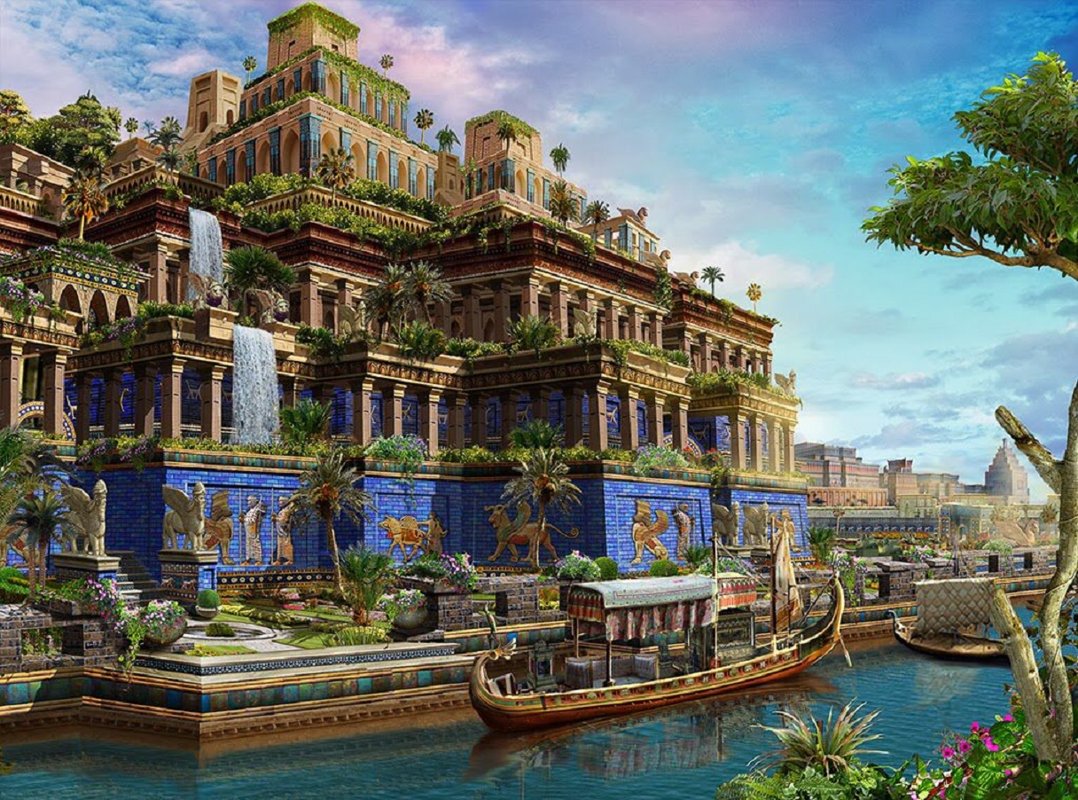 The Hanging Gardens of Babylon were amongst the Seven Wonders of the Ancient World. Those spectacular gardens were actually created for a homesick king’s wife. She yearned for the garden plants of her motherland. Unfortunately, the gardens were all ruined right after the earthquakes in 2nd century BC.It is also during this era that Nebuchadnezzar purportedly built the "Hanging Gardens of Babylon" for his wife because she missed the gardens of her homeland in Media (modern day Iran).
The Hanging Gardens of Babylon were amongst the Seven Wonders of the Ancient World. Those spectacular gardens were actually created for a homesick king’s wife. She yearned for the garden plants of her motherland. Unfortunately, the gardens were all ruined right after the earthquakes in 2nd century BC.It is also during this era that Nebuchadnezzar purportedly built the "Hanging Gardens of Babylon" for his wife because she missed the gardens of her homeland in Media (modern day Iran).

